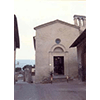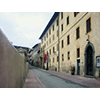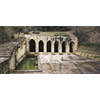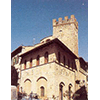Valdelsa - A Valley and Its Treasures

Since antiquity, the Valdelsa has constituted a convenient transit route between the Arno valley and Central Tuscany. It was precisely by exploiting this route that in the Upper Middle Ages, the Via Francigena was developed, along which rose cities destined to a glorious history, such as San Gimignano. In these centres of ancient tradition, you can run into important and unexpected tokens of the scientific history of Tuscany.
The itinerary can start from the city of the towers, San Gimignano, which is home to the interesting Museo Ornitologico. The collection formed between 1860 and 1911, indeed contains very rare specimens.

The specimens in the collection were gathered between 1866 and 1911 on behalf of Marchesa Marianna Panciatichi Ximenes d'Aragona Paolucci, an illustrious Florentine malacologist and amateur ornithologist who, in 1927, donated them to the Commune of San Gimignano. A good part of these specimens came from the estate of Villa del Monte, where two bird snares had been set up with nets for capturing birds attracted by decoys.
The taxidermic preparation of the birds was entrusted to Riccardo Magnelli, taxidermist of the Specola Museum in Florence, while other specimens were stuffed by Dal Nero, the famous taxidermist from Verona who had prepared the birds belonging to the Arrigoni degli Oddi collection, one of the world's most beautiful and most complete, now found at the Zoological Civic Museum in Rome. Arrigoni, the grandson of Marchesa Paolucci, actively collaborated in arranging the collection at San Gimignano, donating numerous specimens and providing consultation in case of birds of uncertain attribution.
The original collection was formed of 1260 specimens. There have remained 696, belonging to 253 different species. The current display, composed of 371 specimens, has been housed since 1990 in the small church of San Francesco, and is managed by the University of Siena Department of Environmental Biology and the National Institute of Wildlife Biology.
(Antonella Gozzoli)
Not far from the Museum, following in sequence Vicolo Santa Fina, Via degli’Innocenti, Via Santo Stefano and Via delle Fonti, the visitor will admire the collection of pharmaceutical vases and glass containers, dated from the 15th to the 19th century, and conserved in the old Spezieria di Santa Fina.

The "Spezieria" forms part, along with the Archaeological Museum and the "R. De Grada" Gallery of Modern and Contemporary Art, of the San Gimignano Civic Museums, housed in the former Santa Chiara Conservatory.
Its origin is very ancient, since it is directly connected to the Hospital of Santa Fina, founded immediately after the Saint's death (March 12, 1253) thanks to the offers of pilgrims and the intervention of the Commune, which promoted its construction and became its sponsor. The Hospital's property was rapidly incremented through donations that allowed the purchase of lands, houses and mills, and during the course of the 15th century it also incorporated other small hospitals. In 1584 it passed under the authority of the Bigallo Magistrature in Florence, remaining so until 1777. Then in 1816 it was united with the Hospital of Santa Maria della Scala in Siena.
Around 1505, two rooms in the Hospital were equipped as a pharmacy; over the course of time, especially between 1679 and 1685, they were extensively remodelled. The space available consisted of four rooms, and the pharmacy was opened to the public. The last enlargement, with seven rooms, dates from 1876, but a few years later the pharmacy was suppressed.
Among the records of the expenses incurred at the time of the great plague epidemics (1630-33) can be read curious accounts of the remedies prepared in the pharmacy and applied during the epidemic. Hundreds of pounds of honey were used as a lenitive and remedy for catarrh. A remarkable quantity of violets must have been used, not only as the ingredient of various medicines, but also to disinfect and perfume the closed areas of the Hospital. It was believed, in fact, that contagion was spread through bad air, and so there was an enormous number of recipes for making scent-balls, to be held to the nose as a "filter" for the air. And to keep the inhaled "poison" from mixing with the saliva, it was recommended to chew bitter roots that disinfected the oral cavity. Sudorific agents or purges were also prescribed to expel the "poison" by sweating or through evacuation.
Today the pharmacy's collection consists mainly of ceramic jars (from the second half of the 15th century to the 17th, coming from the manufactories of Montelupo Fiorentino) and glass receptacles (from the 17th to the 19th century) with medicinal preparations, in addition to various objects and furnishings. The exhibition occupies a small corridor and two rooms, in one of which the pharmacy with its nineteenth-century shelves and counter is reproduced, while the other contains a reconstruction of the laboratory.
(Antonella Gozzoli)
In the lively little town of Poggibonsi, located some 12 kilometres east of San Gimignano and accessible via SP1, you can see a masterpiece of medieval hydraulic engineering, the Fonte delle Fate.

The only architectural evidence on the looming hillock known as Poggio Bonizio, the Fonte delle Fate or Fonte di Vallepiatta is for dimensions the largest public fountain in travertine of the entire territory of Siena, as well as an extraordinary example of medieval hydraulic archaeology. Erected around the first years of the 13th century, probably by the unknown "Magister lapidum" Balugano da Crema, it was interred in 1484 to make room for the construction site of the Medici Fortress ordered by Lorenzo the Magnificent. Following excavation work, in 1803 it was brought to light and later restored. It is formed by a portico with six double round arches supported by pilasters. A canalization system collects the waters from the hill and conveys it to basins situated inside. Sited in an archaeological-environmental park, the fountain today is on the itineraries of villages and castles of the area.
(Cristina Rosselli)
Still in Poggibonsi, 2 km away, a place well worth a stop is also the Museo di Paleontologia, which conserves fossil treasures found in the surrounding territory. It can be reached by taking SP44 and turning onto Via di San Francesco.

Housed in the Palazzo del Pretorio since 1997, the Museum of Palaeontology is managed by the "F.C. Marmocchi" Laboratory, which was founded in 1988 by a group of volunteers, under the sponsorship of the Communal Administration. The Museum is divided into the sections "Palaeontology", "Human evolution " and "Archaeology".
The palaeontology collection includes interesting fossils coming from various localities in the territory of Valdarno, among them mini- and micro-fossils that can be examined through magnifying glasses. The bones of some animals, including the vertebrae and ribs of a whale, are also displayed. The "Human evolution" section illustrates, instead, through informative panels and plaster casts of pre-hominids and hominids, the evolution of human beings up to modern times. In the archaeological section are the remains of the Cucule tomb, from the Calcolithic period, on loan from the Tuscan Archaeological Department.
(Elena Fani)
****************************
Texts by Elena Fani
English translation by Victor Beard
Last update 27/feb/2008



 = libraries and archives
= libraries and archives  = scientific research centers
= scientific research centers  = memorial places of scientists
= memorial places of scientists = public health places
= public health places = places of science and worship
= places of science and worship = places of technology
= places of technology  = museums and collections
= museums and collections  = villas and gardens of science
= villas and gardens of science


